By the 1990s, we knew an awful lot about the Universe. You can check out what the greatest discoveries were (in my opinion) from the 1910s, 1920s, 1930s, 1940s, 1950s, 1960s, 1970s, and 1980s. By this point, we understood the origin of the Universe as well as we understand it today, knew about dark matter and normal matter, and were trying to figure out what the fate of the Universe was. It started with a bang (of course), with a supremely hot (~10^20 degrees), dense, and rapidly expanding state (image courtesy of Stephen van Vuuren):

We knew that there were (and are) two things going on, fighting each other for supremacy. On one hand, everything -- each single particle -- in the young Universe had a tremendous amount of energy. Each particle was flying apart from every other particle as fast as they possibly could. On the other hand, you have gravity, fighting to pull everything back together, and trying to recollapse matter. It's pretty easy to see that on (relatively) small scales, gravity can win, as gravitational collapse has led to the formation of all the stars, galaxies, and clusters of galaxies we observe today.
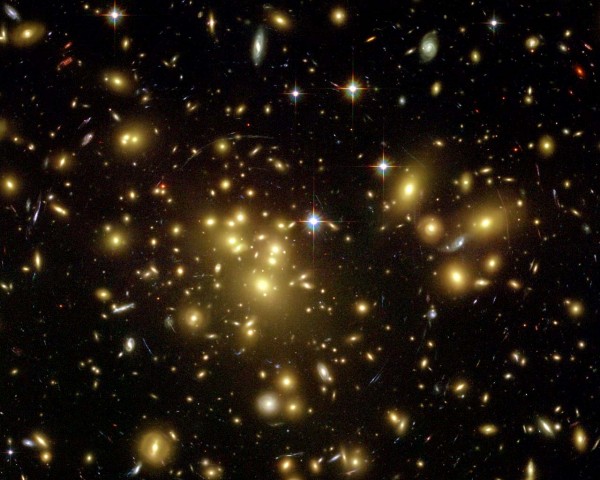
But what happens on the largest scale? What happens on the scale of the entire Universe? You've got this rapidly expanding Universe, and gravity fighting the expansion. As we saw it, there were three options.
- On one extreme, perhaps gravity can do it. Perhaps it's so powerful that it can take this expanding Universe and pull it back together, causing it to recollapse and end in a big crunch.
- On the other far extreme, perhaps the expansion is just too powerful. Perhaps gravity can slow the expansion, but never stop it, and certainly never reverse it. In this case, the Universe freezes to death, and simply coasts off into infinity.
- And there's the "Goldilocks" situation. The first option gets too hot, the second option gets too cold, but maybe the Universe is balanced just right. Perhaps gravity can slow the expansion rate down towards zero, but will never cause it to recollapse. This borderline case, on the cusp between coasting forever and recollapsing, is called a critical Universe.
Illustrated, the three possibilities look like this:

At the same time that scientists were considering these three options, technology had improved to the point where we -- for the first time -- could seriously consider answering this question. The dawn of the 1990s brought us to the launch of the first high-quality space telescope, Hubble:
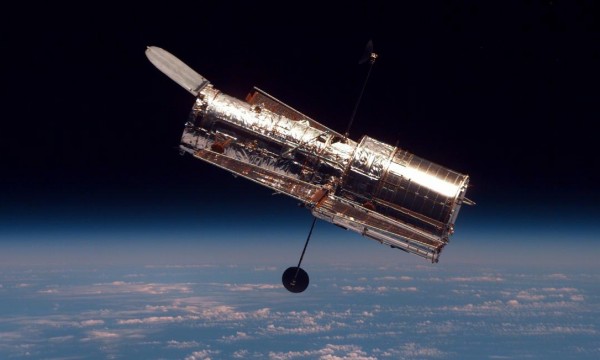
We could now see farther and clearer than ever before, and through a brilliant trick, we could finally hope to measure the entire expansion history of the Universe. Learning what the Universe did in the past would allow us to figure out what it was going to do in the future. So how do we figure it out, and what's the answer?
Imagine you have a 100 Watt light bulb. You know how intrinsically bright it is, right?
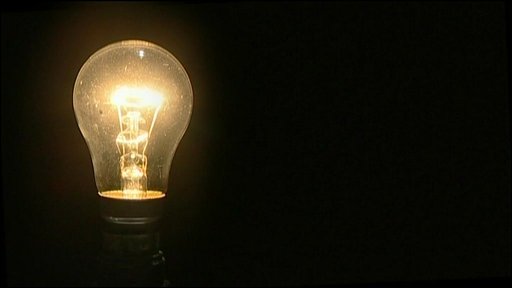
You also know that the farther away it is, the dimmer it appears. In fact, all you have to do is measure its observed brightness and you can figure out how far away it has to be!
Now, there aren't 100 Watt bulbs in space, but there is something close enough that operates under the same principle: Type Ia supernovae. All you need is a white dwarf star that orbits another, larger star:

The white dwarf starts to steal mass from the larger star. When the white dwarf reaches a certain mass -- about 1.4 times the mass of our Sun -- the white dwarf becomes unstable, collapses, and then explodes!
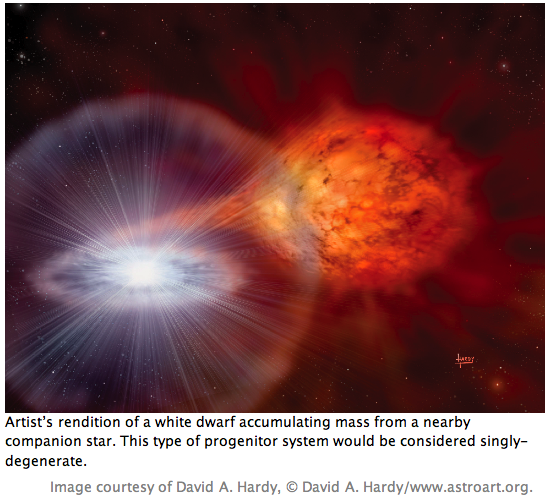
This process is common enough that it happens all over the Universe, producing a Type Ia supernova. These are also standard enough that we can use these to measure distances the same way we would measure the distance to a 100 Watt light bulb by measuring its brightness.
By also measuring the speed that the supernova is moving away from us (remember Hubble's Law and the expanding Universe?), we then know both how far away it is and how fast it's moving. Combine those two pieces of information for enough supernovae, and you learn the expansion history of the Universe.
So, what was it doing? Was it going to recollapse? Was it going to coast off into infinity? Was it right on the edge?
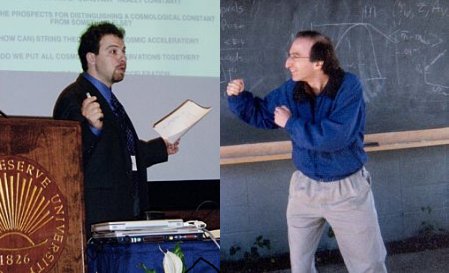
To everyone's surprise, it was doing none of those things. In 1998, two separate teams -- one led by Saul Perlmutter and the other by Adam Riess -- announced that the Universe looked like it was a critical Universe, and then all of a sudden, the expansion rate refused to slow down anymore. Instead of recollapsing, coasting, or riding on the brink of both, the Universe was and is accelerating!

By far, this was the greatest discovery of the 1990s, and one of the most revolutionary discoveries of the entire 20th century. The Universe won't end with a crunch nor with a coast, but with an expansion rate that continues to push things away from us farther and faster. If we lived another 100 billion years, we would find that -- after we merged with Andromeda -- every other galaxy in the Universe was gone from our sight, pushed away by this accelerated expansion.
These early 1998 results were, of course, questioned, but they have held up, and subsequent data overwhelmingly supports an accelerating Universe. Enjoy the night sky while we have it, because someday everything beyond our own galaxy will be hopelessly out of reach.

I will go out tonight and take a picture so my great grandchildrens can see :)
Ethan,
Are you planning on doing another part of this series for the current decade? I realize it isn't over yet, but I think you should.
Sucks that the Universe's expansion is accelerating. We better learn how to traverse space soon, or we're really going to be screwed!
So is there a distinct moment at which a distant object will appear to wink out? How long before the most distant objects are no longer observable?
I've only ever been an amateur regarding the science of the universe, but I grew up reading books that seemed to assume that the big crunch was the most logical fate of the universe. So I was appalled and amazed when I learned that scientists were discovering that the universe was expanding at an accelerating rate. The news was so stunning, it's as if God himself were playing a delightful trick on us! Which of course makes you wonder what else he has in store for us as our scientific capabilities expand.
100 billion years is a long time, Richard -- I don't think there's any rush! ;)
It's not so much wink out as fade away.
And, yeah, it's billions and billions and billions of years away. Human civilization has no right to assume it'll still be around then :)
Note that things we are gravitationally bound to *will* continue to stay near us. That means something like the local supercluster. All the stars in our galaxy will still be there (although they'll not be the same stars, as the galaxy will have evolved a lot). Any galaxy you can see with binoculars and even most small telescopes will still be there. What won't be there is anything beyond that. Those will have moved far enough away that the accelerating expansion of the Universe means that light from them never overcomes the expansion of the Unvierse and reaches us.
I've got a question that has always puzzled me (despite a degree in physics). The way I learned it, the "recollapsing universe" is "closed" (finite in spatial extent), and has the topology of a 4-dimensional hypersphere. OTOH, the "critical" and "coasting" universes are "open" (infinite in extent), and have the topology of a 4-dimensional Euclidian space. (E4? I don't remember much of the terminology). Am I right so far?
So my question is this: if the critical and coasting universes are spatially infinite now, doesn't that mean that have to have been infinite all the way to the big bang itself? After all, I can hardly see how there could be a transition from non-infinite to infinite at any point after the big bang. So doesn't that mean that, at least in those two models, the big bang itself was spatially infinite? This seems very strange to me!
I do understand that these were always just mathematical models of the universe, and that probably nobody ever expected them to match the real universe exactly. So I guess what I'm trying to understand is how seriously physicists take the word "infinite" in these contexts. Do they actually mean it to apply to the real universe? Or are they just saying that some of their models are infinitely large?
Yes, if the Universe is infinite now, it's always been infinite. The Big Bang wasn't a point. The truth is, we don't really understand the "moment of bang" itself. Indeed, I would agree with what Ethan said in one of his earlier posts that nowadays we should consider t=0 to be the end of Inflation. He didn't exactly said that, but he said, effectively, that Inflation is what put the Bang in the Big Bang. Images that try to represent the history of the Universe, including the one in Ethan's post, typically have a "?" before inflation. That's because we don't know anything about it.
So, the Big Bang theory is actually not a great name for the theory, since our current understanding of it doesn't include any "moment of bang" itself. Rather, we start with inflation-- and what came before that is unknown today. If the Universe truly is infinite today, then it was also infinite as inflation was ending.
Of course, it may well be that the Universe is not truly infinite-- but we do know that it has to at least be a whole lot bigger than what we've been able to observe. It is possible that way beyond our horizon, the Universe is in fact finite and bounded. A Universe like that could, as a result of inflation, be flat on the scale that we're able to measure-- see the picture that Ethan had with the ant on an expanding balloon.
Another thing -- the "recollapsing Universe is a hypersphere" only applies if the Dark Energy density is zero. With a positive Dark Energy density, geometry and fate are no longer tied. It's possible to have a closed Universe that expands (and accelerates) forever.
Rob Knop said:
Damn, now we have to keep going out to buy bigger belts.
Rob Knop's comments are very, very good on this, and they ought to be, considering Rob was on one of the teams that discovered this!
There is one point where I disagree with him; I think he's mistaken. Although everything that is gravitationally bound to us will remain gravitationally bound to us, I think it's wrong to say that we're gravitationally bound to the local (Virgo) supercluster. Our local group is just about it. Virgo is huge, massive, and close, but it's still receding from us, and will continue to recede from us at a faster and faster rate. I think us, Andromeda, and our little satellite galaxies are all we've got that's going to hang around, sadly...
Interesting -- I had thought it was everything in the local supercluster. Of course, it depends on your Dark Energy model. (My favorite is phantom dark energy, which eventually rips atoms apart as the Universe dies in a finite time in another singularity!) If we assume vacuum energy, is it enough to tear us away from Virgo? I've never tried to do the calculation myself.
Rob Knop, you said...
"Note that things we are gravitationally bound to *will* continue to stay near us. That means something like the local supercluster. All the stars in our galaxy will still be there (although they'll not be the same stars, as the galaxy will have evolved a lot). Any galaxy you can see with binoculars and even most small telescopes will still be there. What won't be there is anything beyond that. Those will have moved far enough away that the accelerating expansion of the Universe means that light from them never overcomes the expansion of the Unvierse and reaches us."
(I'm not an expert on this, so please keep that in mind, but....)
Isn't it possible that there are already "stuff" in our universe that's already too far away such that "the accelerating expansion of the Universe means that light from them never overcomes the expansion of the Universe and reaches us"?
I love this little series of yours Ethan. Explanations are simple, but not so simple (as in too many TV shows) that people are left wondering how people ever made such assertions. Too many TV shows pretty much just say "geek X made claim A and soon after Geek Y made claim B".
The accelerating universe is a surprise though; are there any easily explained ideas for the continued acceleration?
Gripe or misunderstanding -
the 'three possibilities slide' suggests different 'big bang' times for each possibility?
@Charles Iliya Krempeaux - Yes, it is possible. It is not only possible, but that is our current understanding of it! While we can only see about 13 billion light years around us (age of the universe, speed of light, and all that), the universe is understood to be about 46 billion light years across. So there's a huge gulf of 20 billion light years we can't see! It's quite interesting to me.
Rob, it's everything in the local supercluster, certainly, in a critical Universe. The last time I did the calculation I remember it not even being close; Virgo's Hubble expansion rate from us far exceeds its relative peculiar velocity towards us. In fact, aside from Andromeda, the Triangulum Galaxy, and the Magellanic clouds, nothing else appears to be bound to us. This includes the Sculptor group and the M81 (much less the M87, ha ha) group. It's amazing what just a few Megaparsecs can do with Hubble's law and dark energy.
Madscientist, there are many ideas for dark energy, but none of them are compelling. I emphasize that: none of them are compelling. Certain people will advocate neutrinos, others will blame the vacuum, while Paul Steinhardt will push hard for something called "quintessence." None of these are compelling, which is to say that we don't understand the root of the expansion rate of the Universe.
Rich, neither! You understand it perfectly. In our Universe, the age is about 13.7 billion years. In an open Universe, the age would only be about 12.1 billion years, and in a critical Universe, about 9.8 billion years. I never calculated a closed Universe because it so thoroughly conflicts with observations (and its lifetime would be far too short) as to render it irrelevant, but certainly shorter than 9.8 billion years.
>Enjoy the night sky while we have it,
>because someday everything beyond our own
>galaxy will be hopelessly out of reach.
Umm... everything in the "night sky" (by which most people mean naked-eye) is INSIDE our own galaxy, with the exception of a couple of fuzzy blobs that not too many but the most serious night sky watcher will notice or miss.
I remember for some years a "great attractor" bouncing around as an idea for acceleration. Is there a way to distinguish between an expanding universe, and the existence of "other massive bodies" outside our perception attracting, e.g. a layer of dark matter at the outer edge? I mean, under KISS, something unknown attracting with a known force from the outside sounds at least as reasonable as something invisible pushing from the inside.
there are many ideas for dark energy, but none of them are compelling.
For years now, I've been throwing out this idea for tweaking general relativity to explain dark energy. I assume there's something fundamentally stupid about it, because I never get a response:) Here's to better luck this time.
All you need to do is introduce a law that says the net curvature of space is always equal to zero. Now if this were true, repulsive gravity at a distance becomes a requirement of General Relativity. Any gravitational âdipâ now has a corresponding âbulgeâ.
To better explain what I mean, take the classic the bowling ball on a rubber mat analogy often used to describe General relativity, only throw out the rubber mat and replace it with a waterbed. If you drop a marble close to the bowling ball it will roll towards the bowling ball. Now keep dropping the marble at greater and greater distances, and youâll eventually reach the peak of the bulge created by the bowling ball. Any marble dropped beyond this point will now roll away from the bowling ball.
Mu and Jose,
While there are no compelling theories as to what dark energy is, we know enough about it and about cosmology to know that your proposals are not correct. It's a little technical, but basically, for Mu's idea, the presence of extra matter (in a spherical shell, I suppose) just beyond our horizon would have other effects (such as non-uniform spatial curvature) that we don't see, and that we see evidence against. For Jose's idea, the force law works out all wrong. The correct modification to general relativity to reproduce dark energy is to add a cosmological constant, or something that behaves almost identically to one, which the "waterbed" idea doesn't.
The reason I say nothing is compelling is because adding a cosmological constant to general relativity solves the dark energy problem. There's no motivation to do this, and no understanding of why it has the value we observe. Any other theory/explanation simply reduces to an "effective" cosmological constant, and we don't have anything better.
Sounds like the possible fates of the Universe can be summed up rather concisely: the Big Crunch, the Big Chill, or the Big Rip.
Man my head hurts. Thanks for the post Ethan, I love this stuff even if I only understand about 1/4 of it.
Thanks Ethan, that's why I was asking if we'd know the difference. Guess we do.
Thanks Ethan, but I still don't understand. If you have the time, could you briefly elaborate on how the force laws work out all wrong? My understanding of a cosmological constant is that it's a pervasive force that begins to dominate on a large scale as the density of the universe decreases. How would that be distinguishable from an idea where gravity weakens and eventually becomes repulsive?
@dr. dave: In the middle of nowhere in the southern hemisphere the Magellanic clouds are brilliant - they look just like clouds (which is how Magellan described them). So people who live in areas where those fuzzy blobs are visible will probably miss them if they disappeared.
One thing I don't understand is what is the definition of the boundary of the universe and how can the universe be bounded? Being an earthbound ape I can only imagine how a volume can be bounded if there is matter to prevent objects within that volume from moving beyond the boundary.
@MadScientist - The Magellanic clouds are gravitationally bound to our galaxy, so they won't be going anywhere other than to merge more completely with us.
The reason I say nothing is compelling is because adding a cosmological constant to general relativity solves the dark energy problem. There's no motivation to do this, and no understanding of why it has the value we observe.
Doesn't the Anthropic Principle provide a compelling explanation for the value of the cosmological constant? The most convincing argument I've heard goes like this: "Well maybe our naive calculations for the cosmological constant give us a number too big by a factor of 10^120, but The Landscape(TM) gives us 10^500 possible universes, and at least some of those are going to have the right value, and the others don't matter because there's nobody there".
I know a lot of people don't like the anthropic argument, but personally I find it quite compelling. It works for explaining why the Earth is exactly the right distance from the Sun, and if it turns out there is a natural way to use it to explain other puzzles I don't see the problem!
Jb, I am among those who don't like anthropic arguments at all. Let me see if I can explain why. Come back later today.
Ethan, I encourage you to look up the Big Bounce theory.
You almost had it in your post, when you said "causing it to recollapse and end in a big crunch."
Well, when it recollapses into an infinitely small, infinitely dense singularity, what happens next? The same thing that happens when you massively decrease the volume anywhere else: there is a tremendous increase in pressure, and it EXPLODES in a magnificent flash of energy shooting particles every which way. You might call this a Big Bang.
Like you said, there is a push and pull between Gravity and Entropy. Entropy, always increasing, is always trying to pull the Universe apart. Gravity, also always increasing, tries to bring it back together. As soon as gravity tightens its grip, clenches its fist... entropy breaks free. And as soon as entropy spreads itself out, gravity swallows it all back up.
This same wisdom has been part of Taoist teaching for many millennia:
"In order to contract a thing, one should surely expand it first.
In order to weaken, one will surely strengthen first.
In order to overthrow, one will surely exalt first.
In order to take, one will surely give first.
This is called subtle wisdom."
I cannot accept that there is an absolute "starting point" or "ending point" for the Universe. What happened before the Big Bang?
Infinity goes in all directions. A cyclic Universal theory such as the Big Bounce theory satisfies this.
Thermodynamics First Law: Energy can neither be created nor destroyed. It can only change forms....therefore I believe there isn't boundaries and there's probably galaxies that exist way beyond the farthest we can see.
i need some pictures for a carly simon music video.
,, please donate,. i need to know who to ad a thank you and credits too for any pictures donated,, tears of joy thank you, sincerely peace be with, shawn josed wnkinc.
It might give a perspective :)
http://alexbenedek.blogspot.com/2010/10/existence-anatomy-if-scientist-…
In case of the accelerating universe, why is it that it only accelerates from "now", the red line, instead of accelerating from the Big Bang? Is there a proof that it had been decelerating before? An accelerating universe (al the way from Big bang) would have had much lesser age than what is shown, and in fact lesser than the other cases.
Why are all the model of the universe portrayed as a firework, raisin bread or inverted bell? Doesn't physics show us that all things rotate and revolve and with sufficient motion, align in a vortex and form ellipses and spirals? Why is the universe not looked at the same way galaxies are? Don't all things follow a set of predetermined ground rules, like a mutated Mandelbrot set? Is so, then I say the universe resembles a galaxy; expanding out from a central point or "big Sprocket".
"Why is the universe not looked at the same way galaxies are?"
Because they're different.
"Don’t all things follow a set of predetermined ground rules, like a mutated Mandelbrot set? If so..."
It isn't. The rules are emergent from what the universe does. And the scale of forces involved between stars in a galaxy are vastly different from the ones between galaxies in different clusters.
So the do different things.
For example, you won't see the coriolois force make your bathwater drain the same direction all the time unless you prime it with some swirling of your hands.
And Ron, a bit of a heads-up: with your "Doesn’t physics show us that all things rotate and revolve and with sufficient motion, align in a vortex and form ellipses and spirals?" You are taking the exact same line as chelle who pushed this blog to create a sin-bin thread. Since chelle doesn't like being coralled into reality, she could easiy sockpuppet as she's done before. The little voice is wondering "Is Ron a new sockpuppet?"
Always thought there might be a bit of data to be had in relation to a predicted universe age and or at least how many generations of suns there would need to have been ,to produce, the average amount of iron and carbon existing in a ton of earth....Work backward from the earth instead of forward from a super .. there is still a large degree of guess work involved, yes..except for the starting point..that will be very accurate...Does anyone no if this sort of calculation has been done ?
Yes, something very similar.
The variation is huge, IIRC, about 8 billion years minimum, set by how many supergiants you have early on. Further constraints on that can be set by the scarcity of black hole remnants and push it basically out to about 12 billion, estimating that we *ought* to be able to see them fairly readily.
The maximum is set by how many stars we see now. If they were brown dwarfs, the universe would be a hell of a lot older. Potientially trillions of years, the limit being that we'd have to have had an inexplicable surge of stars of around our size or bigger in the last few billion years and none apparently before then.
But more reasonable estimates put it around 20 billion years max (maybe a little more, can't remember).